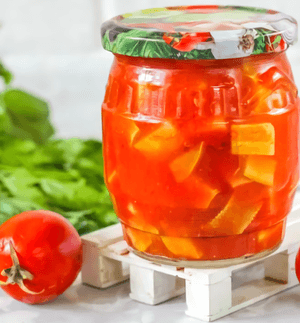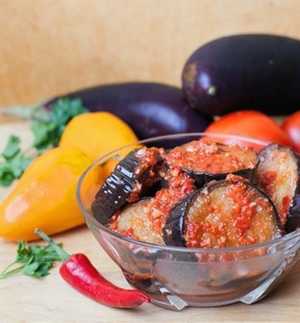Lecho for winter
Preserve the bright taste and aroma of summer with lecho for winter! Simple recipe with steps and tips. Diversify your dishes during the cold season.




Recipe: Lecho for Winter
Lecho is a traditional dish that brings the aroma and taste of summer freshness into your home even during the cold winter months. It is perfect as a standalone dish and as a sauce for pasta, potatoes, and other dishes.
Ingredients
- 1.5 kg sweet red peppers
- 1 kg tomatoes
- 500 g onions
- 2-3 cloves of garlic
- 100 ml vegetable oil
- 2 tablespoons tomato paste
- Salt and pepper to taste
- Spices: paprika, cumin, coriander (optional)
Cooking Steps
- Blanch the tomatoes, peel them, and dice them finely.
- Remove seeds from the peppers and cut them into thin strips.
- Finely chop the onion and mince the garlic.
- Heat oil in a deep skillet and sauté the onion until translucent.
- Add garlic and tomato paste, sauté for a few more minutes.
- Add the peppers, cook until soft and reduced in volume.
- Add the diced tomatoes and spices. Bring to a boil and simmer over low heat for 15-20 minutes.
- Pour the finished lecho into sterilized jars and seal.
Tips
- For a richer aroma, add a bit of fresh basil or oregano before sealing the jars.
- To make the lecho spicier, add a bit of chili pepper or red ground pepper.
- For a richer taste, add some red wine to the lecho before simmering.
- To create a thicker consistency, add some tomato paste or grated cheese.
- To retain the brightness of the vegetable colors, do not overcook them.
- Try adding a bit of honey or brown sugar for a delicate sweetness to the dish.
- To enhance the aroma, toast the spices in a dry skillet before adding to the lecho.
- Serve lecho with grains, rice, or bread for a hearty dinner.
- To retain the brightness and aroma, add a bit of lemon juice at the end of cooking.
- Experiment with different types of peppers and spices to create your unique version of lecho.
- When sealing jars, make sure the lids are airtight to store the product safely.
- Enjoy lecho as a standalone dish or a base for other culinary experiments.
Common Mistakes
- Overdoing the tomato paste can make the lecho too acidic and mask the natural vegetable flavors.
- Prolonged simmering over high heat can lead to a loss of texture and flavor of the vegetables.
- Using overripe or overly soft tomatoes can result in excessive liquid and creaminess to the dish.
- Insufficient simmering of the vegetables can make the lecho raw and insufficiently flavorful.
- Overdoing salt or spices can mask the natural flavors of the vegetables and spices.
- Prolonged simmering over high heat can lead to a loss of texture and freshness of the vegetables.
- Insufficient tomato paste can make the lecho less flavorful and colorful.
- Neglecting to stir during simmering can result in uneven distribution of flavors and aromas.
- Using tangy-tasting tomatoes may require more sugar to balance the taste.
- Overdoing hot paprika or pepper can make the dish too spicy for some tastes.
- Improper sterilization of jars or weakly closed lids can result in spoilage of the product.
- Ignoring ingredient proportions can affect the final taste and texture of lecho.
Fun Facts
- Lecho is a popular dish in the Balkan Peninsula and Eastern European countries.
- Depending on the region, lecho may be more or less spicy and may contain different vegetables and spices.
- Lecho is an excellent way to use surplus vegetables in the season and enjoy their taste even in the winter.
- Lecho can be used as a filling for pies, added to soups, or served with side dishes.
- Colorful peppers can be used in the recipe to give the dish a bright and varied appearance.
- Lecho has counterparts in the cuisines of different countries, such as ajvar (Serbia, Croatia) and malidzhán (Armenia).
- Some recipes add eggs to lecho, giving the dish a richer taste and texture.
- Lecho can be used as a filling for pies, pizza, or sandwiches.
- According to legend, lecho was prepared during the times of the Ottoman Empire and is a popular dish in the Balkan region.
- Meat or sausage can be added to lecho to give the dish a richer protein component.
- Lecho has a relatively long shelf life, making it an excellent option for winter preparation.
- Colorful vegetables can be used in the recipe for a brighter and more appetizing appearance.
- Lecho can be prepared with various spices, allowing for variations in taste and aroma.
- Lecho is a great way to recreate the atmosphere of a warm summer day even in the cold winter months.
- The recipe can be varied by adding other vegetables, such as eggplants or zucchini, for flavor diversity.




